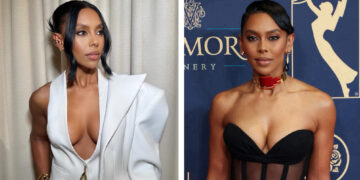Cindy Crawford stands as one of the most recognizable faces in fashion history, transcending the modeling industry to become a cultural icon whose influence spans decades. With her distinctive beauty mark and captivating presence, Crawford redefined what it meant to be a supermodel and paved the way for future generations of models to build multimedia empires.
Early Life and Career Beginnings
Born Cynthia Ann Crawford on February 20, 1966, in DeKalb, Illinois, Cindy Crawford grew up in a middle-class family as the daughter of a tool-and-die worker and a bank teller. Her journey to superstardom began somewhat unexpectedly during her teenage years when she was discovered by a local photographer while working in a cornfield during summer break.
Crawford’s academic prowess was evident early on—she was valedictorian of her high school class and received a full scholarship to study chemical engineering at Northwestern University. However, the allure of modeling proved irresistible, and she made the pivotal decision to leave college after her sophomore year to pursue modeling full-time in New York City.
The transition wasn’t immediate. Crawford faced initial rejections and struggled to find her footing in the competitive modeling world. Her breakthrough came when she signed with Elite Model Management, which recognized her unique combination of girl-next-door accessibility and sophisticated glamour.
Rise to Supermodel Status

The late 1980s and early 1990s marked Cindy Crawford’s meteoric rise to supermodel status. She became synonymous with the era’s definition of beauty, gracing over 600 magazine covers throughout her career. Her collaborations with legendary photographers like Richard Avedon, Helmut Newton, and Herb Ritts produced some of the most iconic images in fashion photography.
Crawford’s versatility set her apart from her contemporaries. She could effortlessly transition from high-fashion editorial spreads to commercial campaigns, making her equally at home in Vogue and popular culture. Her famous Pepsi commercials in the 1990s demonstrated her crossover appeal, reaching audiences far beyond traditional fashion circles.
What distinguished Crawford from other models was her business acumen. She understood early on that modeling careers were finite and began building her brand strategically. Her iconic beauty mark, which some agents initially suggested she remove, became her trademark—a bold decision that emphasized authenticity over conformity.
Media Ventures and Television Success
Cindy Crawford’s transition from modeling to media was seamless and strategic. Her hosting role on MTV’s “House of Style” from 1989 to 1995 revolutionized fashion television. The show brought high fashion to mainstream audiences, making Crawford a household name and establishing her as a fashion authority.
The program’s success lay in Crawford’s natural charisma and ability to make fashion accessible. She interviewed designers, attended fashion shows, and provided behind-the-scenes glimpses into the industry, creating a bridge between the exclusive world of haute couture and everyday consumers.
Her television success extended beyond fashion programming. Crawford appeared in numerous documentaries, talk shows, and special programs, always maintaining her sophisticated yet approachable persona. This media presence helped establish her as more than just a pretty face—she became a trusted voice in fashion and lifestyle.
Business Empire and Entrepreneurship

Crawford’s entrepreneurial spirit led to the creation of multiple successful business ventures. Her home goods line, launched in partnership with various retailers, reflected her personal style and attention to quality. The venture proved that her influence extended beyond fashion into lifestyle and home design.
Her fitness ventures, including workout videos and wellness products, capitalized on her commitment to health and fitness. These products resonated with consumers who admired her dedication to maintaining her physique and overall well-being throughout her career.
The success of these ventures demonstrated Crawford’s understanding of brand extension and consumer psychology. She carefully selected partnerships and products that aligned with her image, ensuring authenticity in every business decision.
Cultural Impact and Legacy
Cindy Crawford’s influence extends far beyond the modeling industry. She represented a shift in beauty standards, proving that natural beauty enhanced rather than hidden could be more powerful than artificial perfection. Her decision to keep her distinctive beauty mark challenged conventional beauty norms and inspired countless individuals to embrace their unique features.
During the supermodel era of the 1990s, Crawford stood alongside Naomi Campbell, Christy Turlington, and Linda Evangelista as part of an elite group that elevated modeling to unprecedented heights. These women weren’t just clothes hangers—they were personalities, brands, and cultural influencers who shaped an entire generation’s perception of beauty and style.
Crawford’s approach to aging in the public eye has been particularly influential. Rather than disappearing from the spotlight, she has embraced each stage of her life, showing that beauty and relevance aren’t limited to youth. Her continued presence in fashion and media demonstrates the lasting power of authentic personal branding.
Personal Life and Philanthropy

Beyond her professional achievements, Cindy Crawford has maintained a strong focus on family and philanthropy. Her marriage to businessman Rande Gerber and their two children, Presley and Kaia, have kept her grounded while both children have followed in her footsteps in the modeling industry.
Crawford’s philanthropic efforts reflect her values and commitment to giving back. She has supported various causes, including pediatric cancer research, inspired by her brother’s battle with leukemia. Her charitable work demonstrates the depth of character that has sustained her career and public respect.
Her approach to balancing career and family has made her a role model for working mothers. She has been open about the challenges and rewards of maintaining professional success while prioritizing family relationships.
Continuing Influence and Modern Relevance
Even decades after her modeling peak, Cindy Crawford remains relevant in contemporary culture. Her children’s success in modeling has brought renewed attention to her legacy, while her business ventures continue to thrive. Social media has allowed her to connect with new generations, sharing insights about beauty, lifestyle, and career longevity.
Crawford’s influence on current beauty standards and modeling practices is undeniable. Many contemporary models and influencers cite her as inspiration, particularly her approach to building a sustainable career beyond physical appearance.
Her timeless style and graceful aging have made her a continued source of fashion inspiration. Designers still seek her input, and fashion magazines regularly feature her in editorials, proving that true style transcends age.
Cindy Crawford’s journey from small-town Illinois to global icon represents more than just modeling success—it’s a masterclass in brand building, authentic self-presentation, and strategic career development. Her influence continues to shape beauty standards, business practices, and cultural perceptions of what it means to be a successful woman in the modern world.
(FAQs) About Cindy Crawford
Q1 What made Cindy Crawford different from other supermodels of her era?
Cindy Crawford distinguished herself through her business acumen, media savvy, and authentic personality. Unlike many models who focused solely on fashion, Crawford built a multimedia empire including television hosting, business ventures, and strategic brand partnerships. Her decision to keep her distinctive beauty mark and embrace her natural features also set her apart from conventional beauty standards of the time.
Q2 How did Cindy Crawford transition from modeling to business success?
Crawford’s transition was strategic and gradual. She leveraged her modeling fame to launch “House of Style” on MTV, establishing herself as a media personality. She then expanded into business ventures including home goods lines, fitness products, and various partnerships. Her approach was to align business opportunities with her personal brand and values, ensuring authenticity in every venture.
Q3 What impact did Cindy Crawford have on beauty standards?
Crawford challenged conventional beauty norms by embracing her natural features, particularly her famous beauty mark, which agents initially suggested she remove. She represented a shift toward more natural, accessible beauty that combined sophistication with girl-next-door appeal. Her influence helped broaden beauty standards and inspired others to embrace their unique features.
Q4 Is Cindy Crawford still active in the fashion industry?
Yes, Cindy Crawford remains active in fashion and media, though in a different capacity than during her supermodel peak. She continues to appear in fashion campaigns, magazine editorials, and maintains business ventures. Her children’s modeling careers have also brought renewed attention to her ongoing influence in the industry.
Q5 What is Cindy Crawford’s legacy in the modeling industry?
Crawford’s legacy includes elevating the modeling profession beyond mere fashion display to multimedia entertainment and business success. She helped define the “supermodel” era of the 1990s and demonstrated how models could build sustainable careers through strategic branding and diversification. Her influence continues to guide contemporary models and influencers in career development and brand building.
For More Information Visit Bratish Magazine

















































































